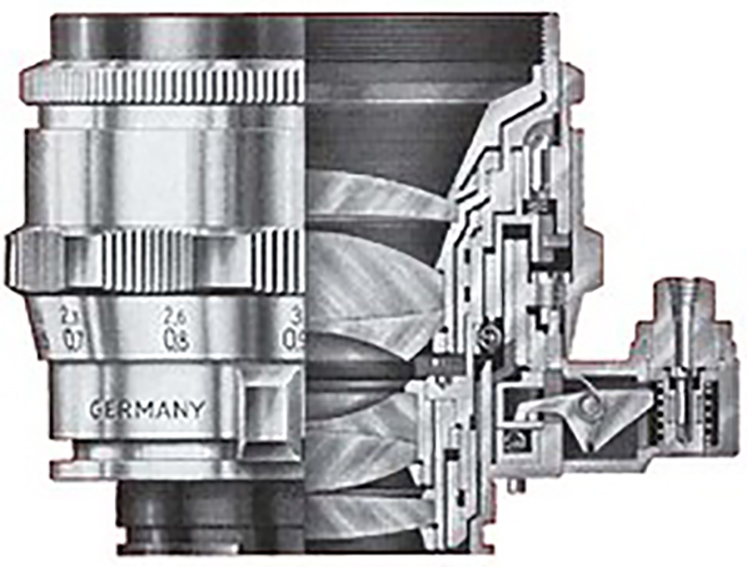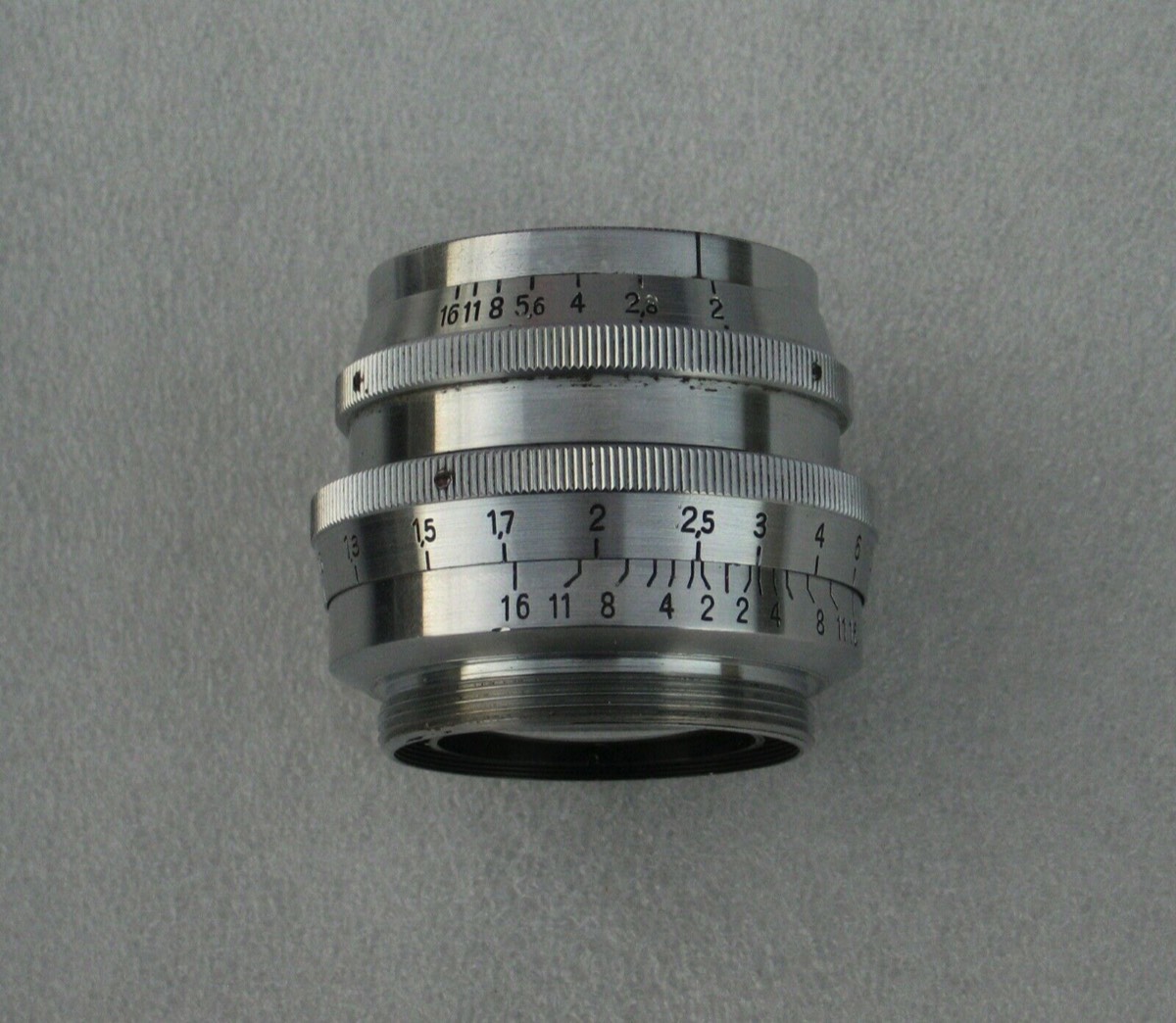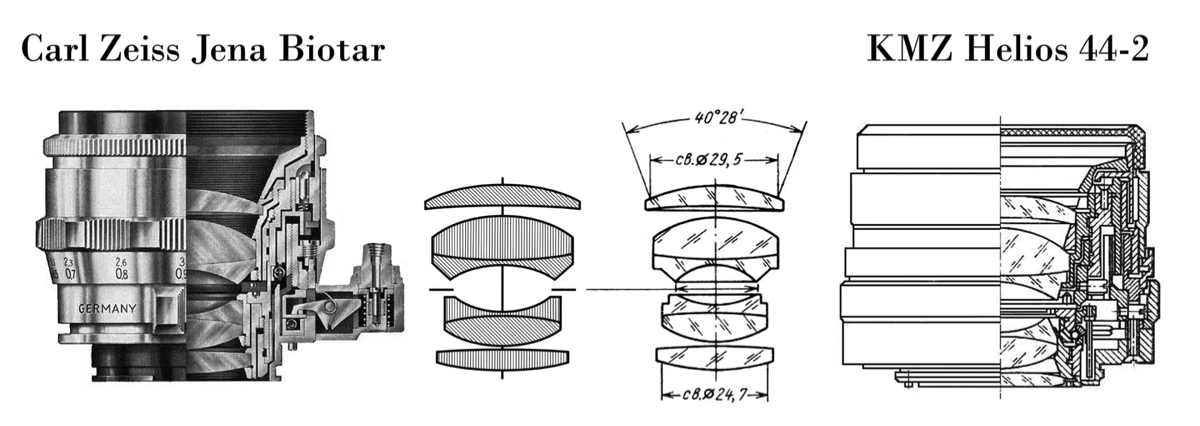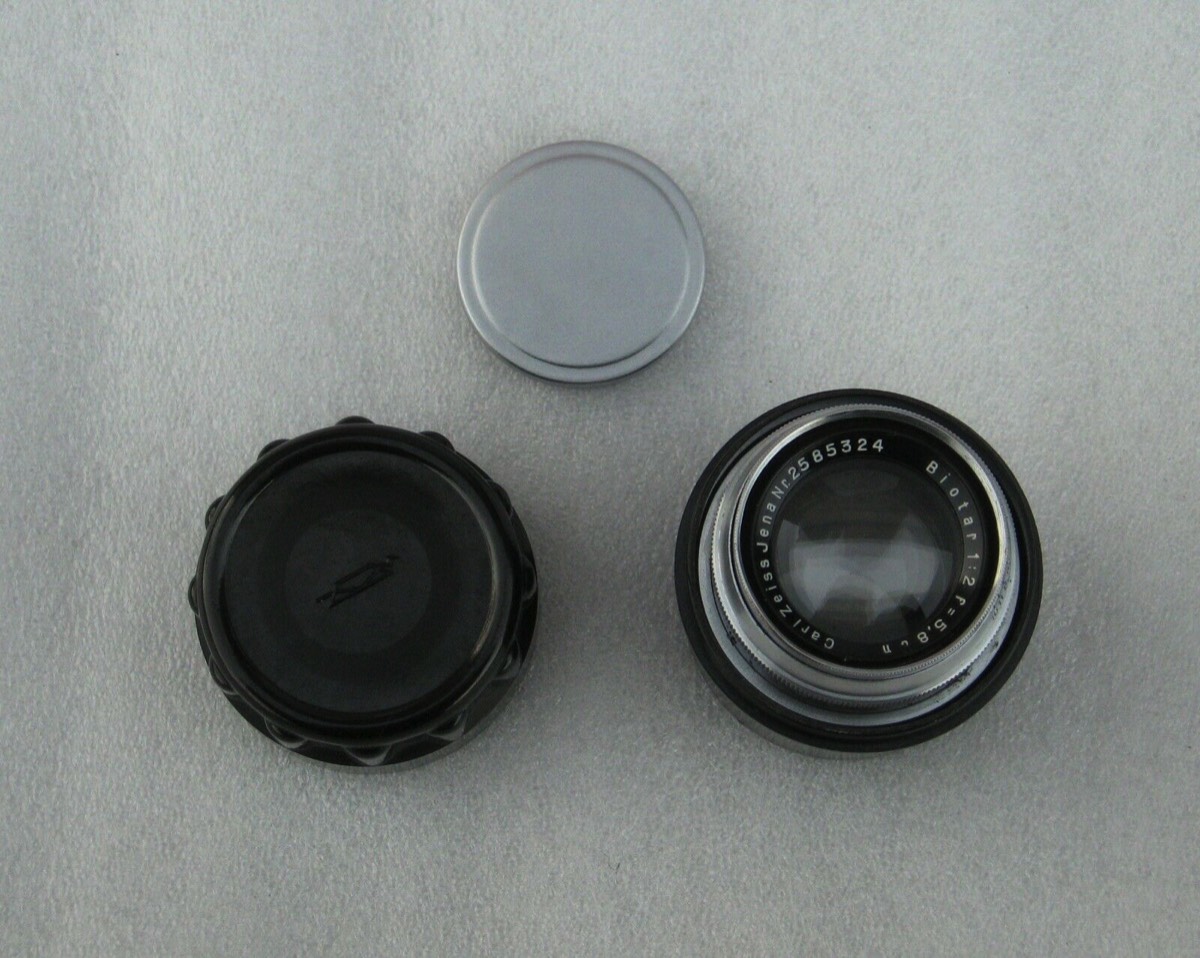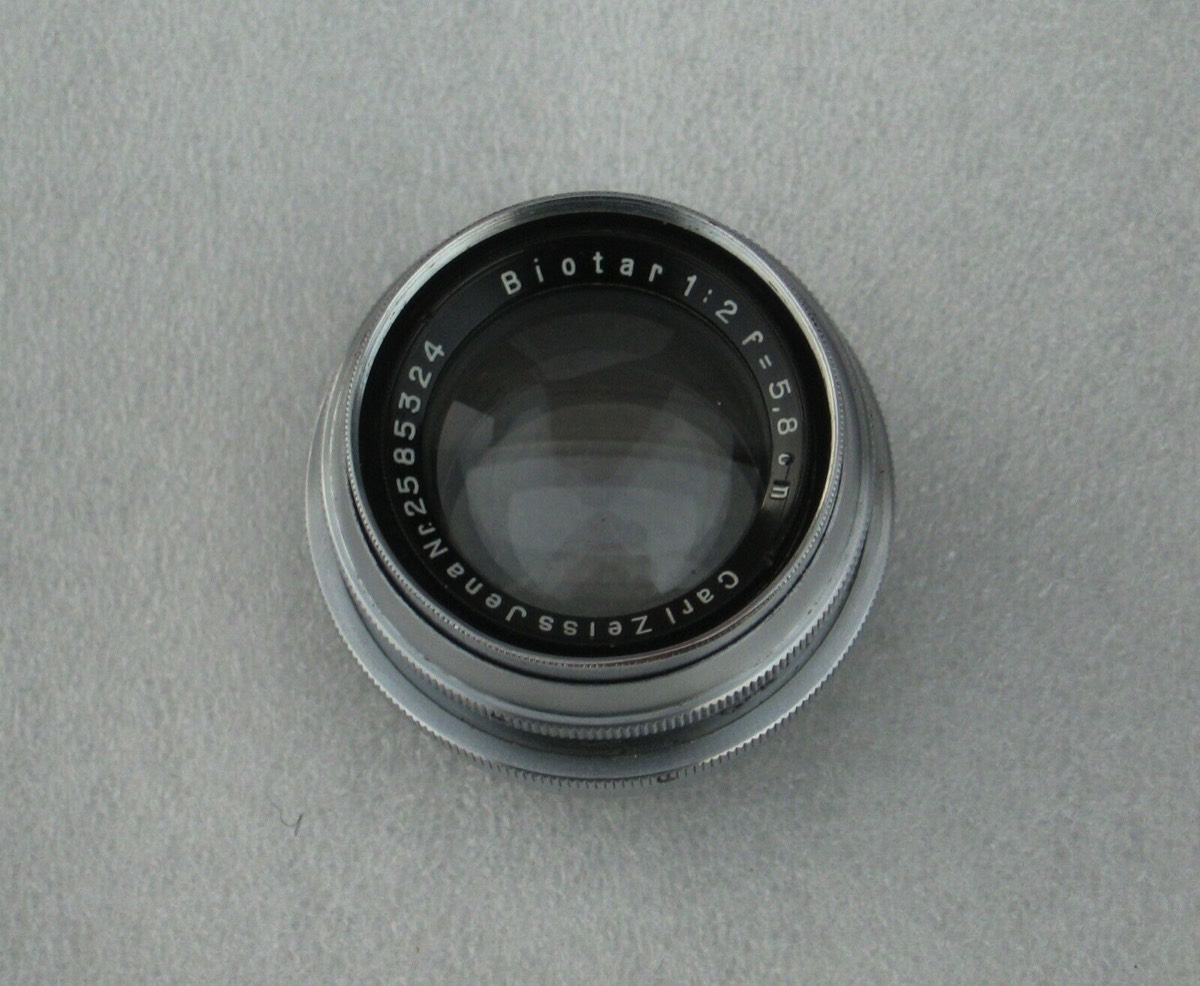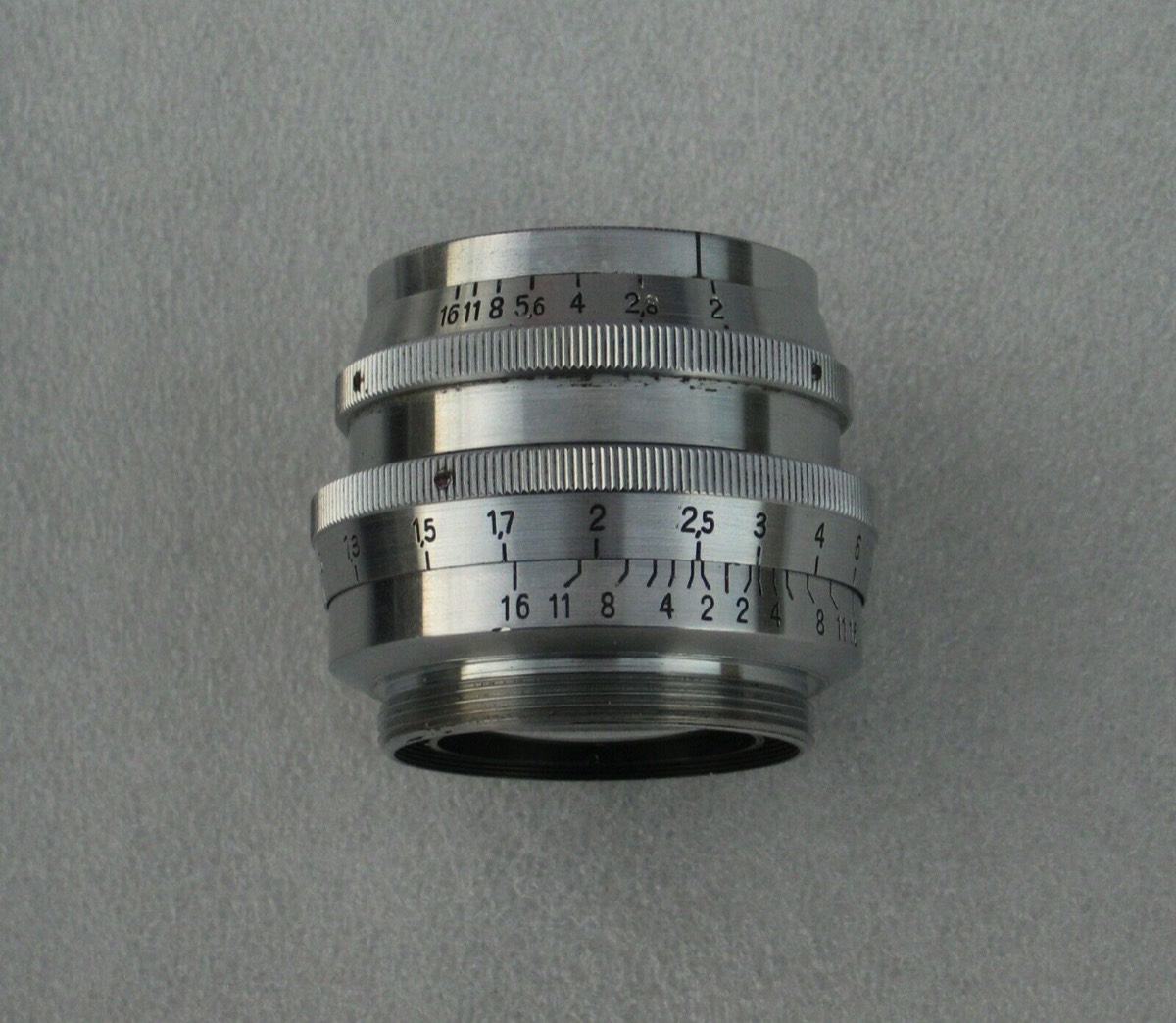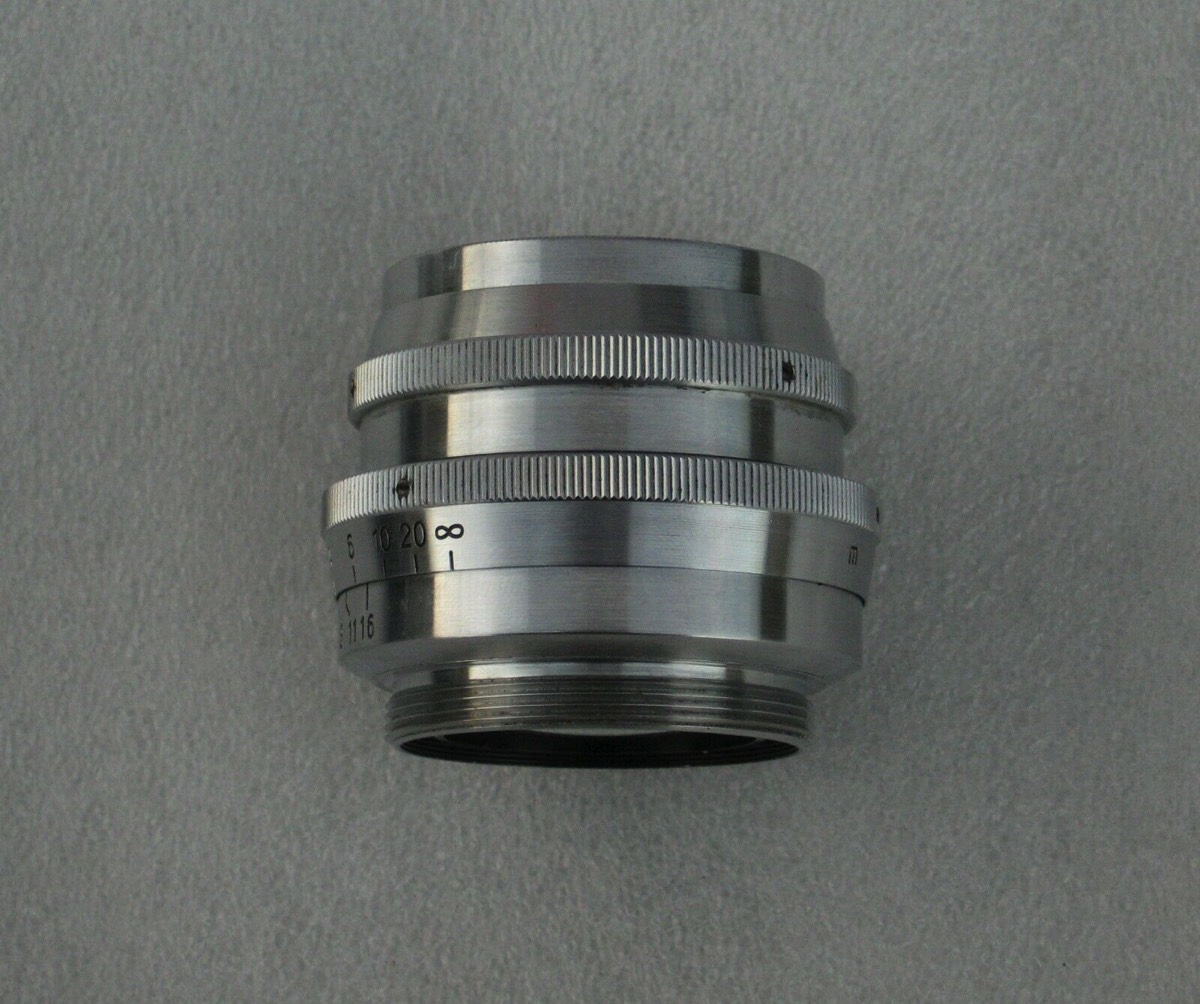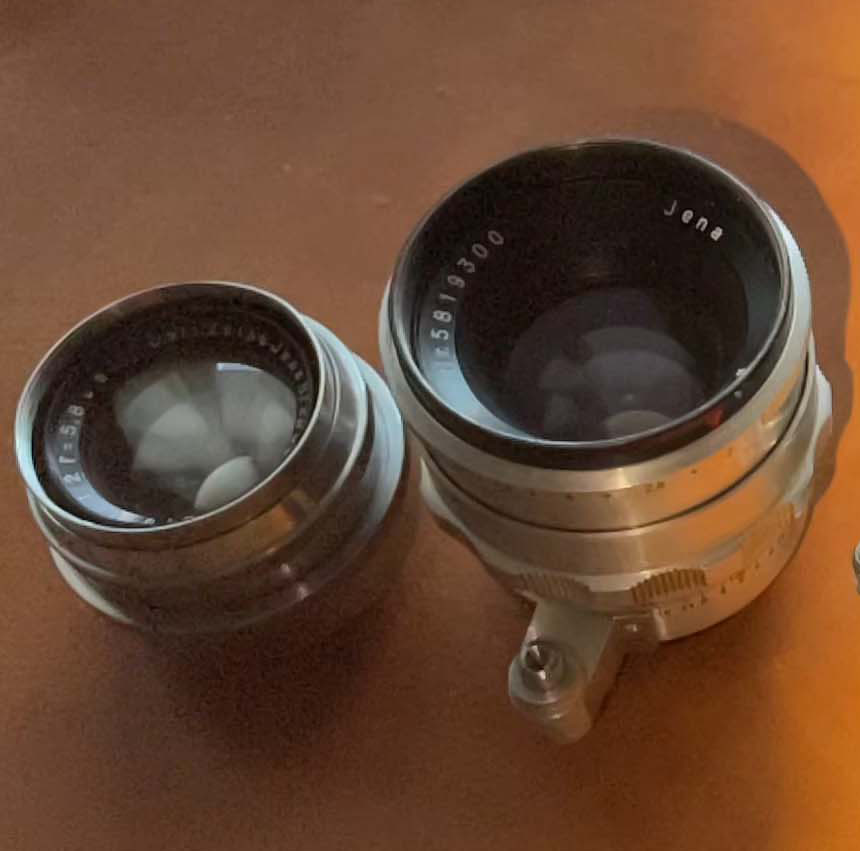Pre War 1939 Brass Uncoated Carl Zeiss Jena Biotar 2 5,8cm Praktiflex M40.
History
Carl Zeiss was born in Weimar on 11 September 1816. He built microscopes in Jena from 1846 onward.
The correct way to pronounce "Jenna" is to make it sound like "Yenna" in English.
The history of Zeiss mirrors German history and all of its highs and lows. It was founded as a business in 1846. World War I, the global financial crisis and World War II were years of ups and downs.
Carl Zeiss Jena had become a Social-Democratic bulwark. From 1933 and through World War II Carl Zeiss supported the Nazi regime as did most major German industries. About 1937 the atmosphere at Dresden changed (something was coming) and civilian projects were put on low priority, and military items, such as gunsights, bombsights, etc were being pushed. The prototypes were kept in the lower (second) basement level and all further work was done by the devoted staff on their own time, usually during the lunch periods.
When World War II began in September 1939 there was an air of invincibility in Germany, and in keeping with traditional practice, Zeiss products proudly borne the makers trademark and city of origin of the product. Forced foreign labourers (Fremdarbeiter) were brought to work at Carl Zeiss Jena manufacturing facilities.
Hubert Merwin was Director of the design department of Zeiss-Ikon Dresden from 1932-1945 and Zeiss-Ikon Stuttgart from 1945-1949. When Mr. Nerwin joined Zeiss, the first CONTAX camera (later designated as Contax I) was already in production. Zeiss made numerous improvements in the camera design many of them affecting the external appearance. The camerastore-owners complained to Zeiss Ikon, that the frequent changes harmed the sales. Mr. Nerwin estimated, that during the course of two years, there were design changes (external and/or internal) about every three months; naturally, some of those changes were minute, and not necessarily discernible by the dealer/customer. In 1933 it was decreed, that no more external changes should be made on the Contax I. All the improved concepts being developed, were to be incorporated in the forthcoming CONTAX II, then on the design boards.
This explains the various Contax I versions, while the Contax II and the subsequently released Contax III, seemed to be completely uniform in appearance. Actually, the Contax II and III also contained internal changes—but by decree, none of these changes were to be detectable by the dealer/customer, judging external appearance.
But this is not just a Biotar 58 f2, this is a 1939 pre war lens and one of the rarest in my collection as it was the first Praktiflex lens to be made. This brass lens is just a piece of pure history.
The Praktiflex mount was a screw thread lens mount, with a diameter of 40mm, introduced with the Praktiflex, a 35mm SLR by KW.
The Praktiflex is a 35mm SLR film camera, manufactured by Kamera-Werkstätten VEB Niedersedlitz, (KW) Dresden, former East Germany and produced between 1939-49. KW was the third manufacturer to introduce a 24×36 SLR camera; only the Kine Exakta and the Russian Sport preceded it. Also, the Praktiflex was the world's first small-format SLR camera with a returnable mirror and with a screw mount for interchangeable lenses.
Its successor, the Praktica, became a very long and successful series of models.
The Praktiflex has a special 40mm in diameter screw thread lens mount, and takes only Praktiflex lenses. The 42mm thread mount became available from about 1947, and was thus initiated by this manufacturer. This lens mount became practically an universal industry standard, until about 1975 when the need for increased exchange of information between camera and lens made the bayonet mount a more practical arrangement.
There are many models and variants of the Praktiflex. They could be divided two main generations. [1] The first generation includes pre-WW2 models and the second generation includes post-WW2 models.
We can make a list of the Praktiflex lenses.
Carl Zeiss Jena
5.8cm f/2 Biotar
5cm f/2.8 Xenar
12cm f/4.5 Meyer Trioplan
5 cm. f/3.5 Zeiss Tessar
5 cm f/2.9 Victar
Difference between pre-war brass Biotar lens (left) and aluminium post war Biotar lens (right).
In 1945 the U.S. Third Army advance, and on April 13 the regimental combat team 80th Division cleared Jena where they found the Carl Zeiss factory complex. It had sustained what they described as "surprisingly little effective bomb damage"
After the defeat of Nazi Germany in WWII, in compliance with the Yalta agreements the U.S.military forces departed. In June or early July the Russian military forces occupied Jena and the remainder of what became East Germany (German Democratic Republic). Russians 'appropriated' the original optical equipment and designs from Carl Zeiss factory in Jena. Carl Zeiss know-how was one of the most prized possessions of the post-war era and helped accelerate innovation in the USSR's optical industry, After the war ended, the Contax RF model dies were taken by the Russians to Kiev, along with certain drafted Zeiss staff, to replace the lost or missing dies and production tools. By one year later, the Russians had evacuated much of the remaining technical and management staff and about 92% of the Carl Zeiss Jena manufacturing facilities to the east. But the Russian fear of possible further conflict with the western allies rendered moving any production capability into a more defensible Russian province a sensible strategic step.
The Zeiss staff remaining at Dresden, then decided to proceed with the production of the Contax SLR model; because of the departure of the Contax dies, the Zeiss staff decided to change tho lens mount and use a 42mm screw-in mount, and chose to use a horizontally moving, cloth focal piano shutter, because the tooling for a cloth shutter was much Simpler, and quicker. The postwar Dresden Contax SLR was produced under the direction of Mr. Winzenburg, who took over the design group after Nerwin left for Stuttgart where they assembled assorted prototypes, machine tools, dies, hand tools and trucked in to Berlin-Zellendorf. Production resumed in September 1945. It took the Stuttgart team seven weeks to return to Stuttgart with American military assistance) because of Russian intransigence.
So after WWII, there were suddenly two Zeiss-Ikon companies, one in East and the other in West Germany. The "Zeiss Stiftung von Jena" established at Heidenheim with the "Opton-Optische Werstatte Oberkochen GmbH" factory at Oberkochen on the banks of the Kocher River near Stuttgart. The Schott Glass Works subsidiary was located at Mainz.
The West German branch, in Stuttgart, developed an all-new line of rangefinder cameras using the Contax bayonet lens mount, and launched the Contax IIa in 1950. Meanwhile, the East German group completed work on an all-new SLR camera that had been in development since the beginning of the War. This camera was introduced at the 1948 Leipzig Fair as the Contax S. The Contax S was the originator of the M42 lens mount, which was immediately adopted by KW as they reintroduced the prewar Praktiflex as the Praktica with the new mount. In addition to introducing the M42 mount, the Contax S also gave us the first eye-level pentaprism viewfinder, and it was also the first optical viewfinder system to provide (with the standard 58/2.0 lens attached) a 1:1 magnification in the finder. Zeiss was reformed in West Germany and became Zeiss Icon, Early 1970's tensions between the two firms between the two firms peaked (as they did between East and West) with each of both companies claiming the exclusive rights to the patents, trademarks and traditions of "Carl Zeiss". This culminated in a series of legal battles around the globe, among these was one resolved by U.S. Supreme Court granting rights to the name "Zeiss" to the West German Zeiss firm. Many trademark disputes followed with the part that was left in East Germany. Stuttgart became the Wests company's domicile.
Zeiss Ikon merged in the mid 1960s with Voigtländer, another important German manufacturer, and one that had been controlled by the Zeiss Foundation since 1956. Zeiss Ikon ceased the production of cameras in 1972. This was a great shock for the entire German camera industry. Parts of the Zeiss Ikon product line then went to Rollei, and part of the know-how was used to revive the Contax name in collaboration with the Japanese maker Yashica.
This Lens
This is a very special version of this lens. It is a brass 1939 version of the lens. Maybe you are wondering why someone would want a heavy version of a Carl Zeiss lens when there are aluminium versions. Whilst the internet is full of supposedly pre war aluminium versions of Zeiss lenses these are all fakes made in Russia after the war. Zeiss ONLY made brass lenses before the war.
More than 90% of the pre war and wartime Zeiss lenses are fakes you have to know what you're looking for. Zeiss Sonnar lenses of World-War-II-era are often faked from vulgar Russian Jupiter lenses by simple changing the front-ring, and sometimes engraving the barrel with "Made in Germany" or changing the ring to a pre-war number sequence. This faking is alleviated due to the fact that parts of the Carl Zeiss Jena lens plant and machines were disassembled and rebuild in Russia after the war, as well with many workers, engineers, parts and maybe whole lenses going with them, and were build quite unchanged as Russian lenses until youngest present. So it's hard to distinguish them.
If the serial number is pre-war it is easy to check for fakes. In peacetime Carl Zeiss lens barrels were all made of brass, in wartime alloy. Since all Russian lenses are made of alloy, you never see a brass fake. Even true ZEISS wartime alloy lenses were not made up to peace standards, materials and quality control. The alloy barrels don't withstand well the ravages of times. As a collector who likes to use that stuff actually I don't see a reason why to pay a lot of money for a fake, but at a good price that is OK. All my pre-war lenses here on this site are brass thus not fakes.
Like many lenses, the Biotar 58mm has a long genealogy. This ancestry stretches as far back as the 1920s, a time when several lens manufacturers were attempting to improve the Carl Zeiss Planar design that originally debuted in 1896.
The Biotar lens formula was first created for Carl Zeiss by the famous lens designer Willy Merté in 1927, and was originally made for movie cameras. It boasted a Double Gauss design with six elements in four groups, offering an improvement of the Triplet or Tessar designs which aim for higher performance. The field correction and the speed are increased in comparison with more simple designs.
Merté continued developing and experimenting with his Biotar lens design for years, and in 1938 the lens was reconfigured as a 35mm lens for the Exakta camera. Creating such a fast lens prior to World War II was one of the greatest feats in the history of optics, especially true considering it was designed and built without the use of computers. All optical calculations were done by hand by teams of optical technicians. Virtually all of today’s fast lenses with a medium field angle (50-100mm focal length with 35mm SLR cameras) are successors to the Biotar design, a worthy testament to the skills of Merté.
The Helios 44 58 also included on this site is a Russian version of the Biotar but differs slightly as the Zeiss Biotar is made with German Schott glass which was not available in the Soviet Union so the optical formula has to be slightly modified for the Helios copy of this lens. Also look at Cyclop H3T 85 f1.5 as this is a Russian military copy of the Biotar 85 f1.5 which sells for thousands on eBay. You do not have the aperture but for the Bokeh your better of without it!
These Double Gauss lenses attempted to improve on the Planar design from 1896 by abandoning the strict symmetry approach for the radii of curvature of the surfaces and the refractive indices of the glass materials, and therefore achieved additional correction parameters. The asymmetry means that the front three-part lens group was overall larger than the group behind the diaphragm. Furthermore, the two outer collecting lenses are each of a larger diameter than the two inner lens pairs. Virtually all of today’s fast lenses with a medium field angle (50-100mm focal length on 35mm cameras) are Double Gauss designs, like the Biotar.
This lens was made for a limited production camera:
Produced between 1939-46
Lens: camera offered with various brand's lenses
Mount: M40x1 screw type
Focusing: via condenser type ground-glass focusing screen
Shutter: horizontal-run rubberised cloth-blind type shutter speeds: 1/25-1/500, +B
Shutter release knob: on the top of the camera
Mirror: instant return, raises by pressing the release button. Shutter releases only when the mirror is raised.
Viewfinder: Waist-level view finder with condenser type ground-glass focusing screen (Stevens Screen), fixed, w/ Magnifier and eye level sports finder
There are some variants with special coloured leatherette like red, blue, gray.
Some variants have no strap lugs and some variants have strap knobs
Very soon KW abandoned the 40mm mount and adopted the 42mm screw mount introduced with the Contax S. Today the Praktiflex lenses are rare.
Lens In Use
• When used wide-open, field-curvature and spherical aberration spreads the depth-of-field across the frame, giving a “3-D” look.
• Open up to F4 and the image is sharp across the field.
• The bokeh of the Carl Zeiss Jena Biotar 58 mm f/ 2 has a characteristic twirling with the aperture wide open, this first edition of the lens has less of a swirl to the later models.
• In general, the lens renders very flexible, and, at the same time, sharp image.
• Back, side and scattered light is not well handled, the use of a hood is recommended. There are chromatic aberrations discernible in contrast images.
• The variants with multi-blade iris and instant-return apertures were produced. The aperture had the different number of blades: 17,12,10, 8. This brass one has 8.
Summary
Optically, the lens is a perfect and fun. It is reasonably sharp wide open and very sharp stopped down. Contrary to some reports of swirly bokeh, my lens does not produce swirly bokeh like the 8-bladed Helios 44-2. It does swirl a bit in the right conditions, but not as much as the Helios. The lens does benefit from a lens hood.
For general information on lens design and lens elements go to the homepage
HERE 
